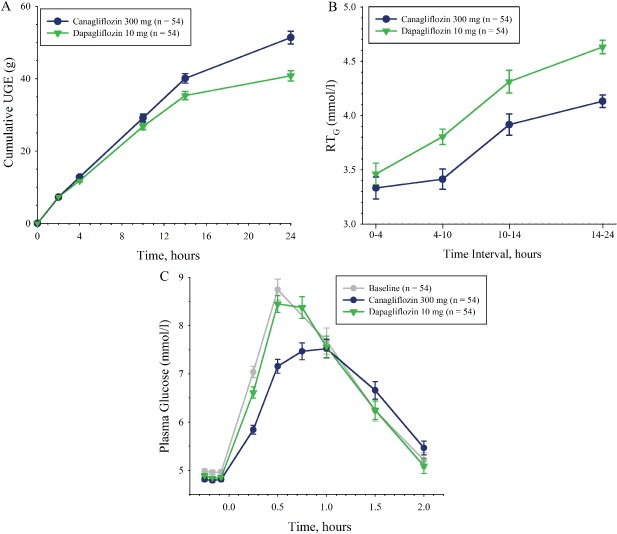FYI: in this small trial in people with MCI but without T2D after 12 weeks they observed a small reduction in Hb A1C (-0.18) and what I think is a more significant reduction in “2-hr Glucose Area Under the Curve (- 2109.0 mg min/dL, p=0.03)”.
There are many very large trials of SGLT2 in non-diabetic people (for CKD and HF). For instance, in DAPA-CKD, “of 4,304 participants, 738 had normoglycemia, 660 had prediabetes, and 2,906 had type 2 diabetes.” They found that (see: Efficacy and Safety of Dapagliflozin by Baseline Glycemic Status: A Prespecified Analysis From the DAPA-CKD Trial 2021):
The effect of dapagliflozin on the primary outcome was consistent (P for interaction = 0.19) in normoglycemia (hazard ratio [HR] 0.62 [95% CI 0.39, 1.01]), prediabetes (HR 0.37 [0.21, 0.66]), and type 2 diabetes (HR 0.64 [0.52, 0.79]).
Our findings from a dedicated kidney outcome trial substantiate the findings from the Canagliflozin and Renal Events in Diabetes With Established Nephropathy Clinical Evaluation (CREDENCE) study, suggesting that the kidney benefits seen with SGLT2 inhibition appear to be independent of their glucose-lowering effects, and extend these results further to those with prediabetes and normoglycemia at baseline.
Few studies have investigated SGLT2 inhibition in prediabetes. During a 13-week randomized comparison between dapagliflozin, metformin, exercise, or control intervention, Færch et al. found that dapagliflozin treatment led to improved glycemic variability, with minor reductions in HbA1c (0.1% or 1.3 mmol/mol) and fasting plasma glucose (0.1 mmol/L or 1.8 mg/dL).
In participants with normoglycemia or prediabetes, dapagliflozin reduced the risk of kidney outcomes without improving glycemic control. These data are in keeping with an analysis of the CANagliflozin cardioVascular Assessment Study (CANVAS) trial, where markers of glycemia did not explain the effect of canagliflozin on kidney outcomes. Instead, albuminuria, hemoglobin, and hematocrit were identified as important mediators, pointing to a potential reduction in fluid overload. The recognized effect of SGLT2 inhibitors on hemoglobin and hematocrit may reflect improvement in renal hypoxia and restoration in the hypoxia-inducible factor 1α/2α balance, stimulating erythropoiesis and reducing inflammation. Glucose-independent effects may include osmotic diuretic and natriuretic effects as observed in individuals with type 2 diabetes and CKD.
(since then, a recent paper showed that the benefits were probably not due to osmotic diuretic effects, so it’s still a mystery  )
)
Here’s the paper on variability: The effects of dapagliflozin, metformin or exercise on glycaemic variability in overweight or obese individuals with prediabetes (the PRE-D Trial): a multi-arm, randomised, controlled trial 2020
One hundred and twenty participants with BMI ≥25 kg/m2, 30–70 years of age, and prediabetes (HbA1c 39–47 mmol/mol [5.7–6.4%]) were randomised 1:1:1:1 to dapagliflozin (10 mg once daily), metformin (1700 mg daily), interval-based exercise (5 days/week, 30 min/session) or control (habitual lifestyle). Participants were examined at baseline and at 6, 13 and 26 weeks after randomisation. The primary outcome was the 13 week change in glycaemic variability (calculated as mean amplitude of glycaemic excursions [MAGE]) determined using a continuous glucose monitoring system (pre-specified minimal clinically important difference in MAGE ∼30%).
One hundred and twelve participants attended the examination at 13 weeks and 111 attended the follow-up visit at 26 weeks. Compared with the control group, there was a small decrease in MAGE in the dapagliflozin group (17.1% [95% CI 0.7, 30.8], p = 0.042) and a small, non-significant, reduction in the exercise group (15.3% [95% CI −1.2, 29.1], p = 0.067), whereas MAGE was unchanged in the metformin group (0.1% [95% CI −16.1, 19.4], p = 0.991)). Compared with the metformin group, MAGE was 17.2% (95% CI 0.8, 30.9; p = 0.041) lower in the dapagliflozin group and 15.4% (95% CI −1.1, 29.1; p = 0.065) lower in the exercise group after 13 weeks, with no difference between exercise and dapagliflozin (2.2% [95% CI −14.8, 22.5], p = 0.815).
So dapagliflozin improves the glycemic variability of prediabetic overweight people as much as daily interval training. What about normoglycemic non-overweight people?
This study was done after 4 days. My guess (based on my own experience + the above papers) is that the effects of SGLT2i are more systemic and take a few weeks or months to kick in.
